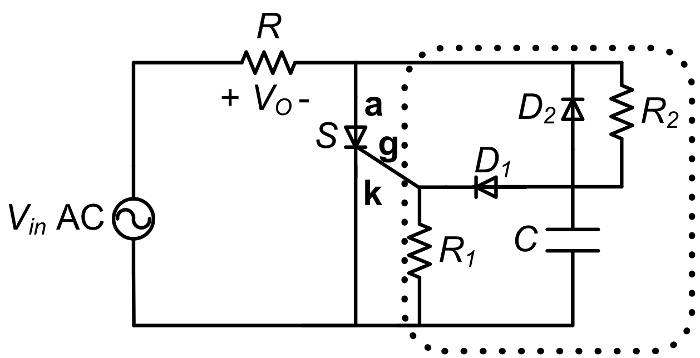サイリスタ整流器
概要
ソース: アリ バッツィ、電気工学科大学コネチカット州ストーズ、ct 検査
ダイオードと同様に、サイリスタ、シリコン制御レクティファイヤ (Scr) とも呼ばれる陽極から陰極に電流を一方向を渡すし、他の方向に電流の流れをブロックします。しかし、現在の通路はゲートを通過」「ターミナル、ので、導電性サイリスタ オンに小さな電流パルス必要とする制御できます。
サイリスタ、n 型の交互になる層と p 型材料から成る 4 層デバイスですそれにより 3 つの接点の PNPN 構造を形成します。サイリスタには 3 つのターミナル;PNPN 構造の p 型材に接続して陽極、陰極が n 型層に接続し、門が最寄りのカソード p 型層に接続されています。
この実験の目的は、異なる条件下で制御サイリスタ半波整流器を研究し、ゲート パルス影響 DC 出力電圧の異なるタイミングを理解することです。
手順
注意: この実験中に通電中の回路の任意の部分に触れないでください。変圧器が接地します。
この実験のため 60 Hz のユーザヘと 35 V のピークで可変トランス (変圧器) は、メインの AC 電源として使用されます。
1. セットアップ
- 始める前に、1 つのスコープ チャンネルに差動プローブを接続します。
- 1/20 (または 20 X) 差動プローブの減衰のボタンを設定します。
- スコープ チャンネル メニューで 20 X が差動プローブの使用可能な限り、10 X とプローブを設定します。場合 10 X を選択すると、手動で任意の測定や結果 2 倍希望 X 20 に到達します。
- セットアップは、変圧器を VARIAC の出力 (通常容器のように見える) が任意のケーブルに接続されていないことを確認します。
- VARIAC オフにしておくし、そのノブがゼロに設定されていることを確
結果
申請書と概要
SCR の AC 入力から可変 DC 出力電圧を必要とする古い DC 電源に一般的であった。上記の回路の抵抗R2を調整すると、 Vを平均を調整することが可能だし、その調整可能な DC 電源供給の結果。Scr は 10 以上 DC 電源の入力ライン周波数 (通常 50 または 60 Hz)、新しい彼らのスイッチとして電源供給スイッチが一般的ではない s や 100 kHz やすく小さいコンデンサーで DC 成?...
スキップ先...
このコレクションのビデオ:

Now Playing
サイリスタ整流器
Electrical Engineering
17.6K 閲覧数

電気の安全上の注意および基本的な装置
Electrical Engineering
144.7K 閲覧数

磁気コンポーネントの特性評価
Electrical Engineering
15.1K 閲覧数

電源基板をポール入門
Electrical Engineering
12.5K 閲覧数

DC-DC 昇圧コンバーター
Electrical Engineering
57.1K 閲覧数

DC/DC 降圧コンバーター
Electrical Engineering
21.2K 閲覧数

フライバックのコンバーター
Electrical Engineering
13.3K 閲覧数

単相変圧器
Electrical Engineering
20.2K 閲覧数

単相整流器
Electrical Engineering
23.5K 閲覧数

単相インバーター
Electrical Engineering
18.0K 閲覧数

DC モータ
Electrical Engineering
23.4K 閲覧数

AC 誘導モータ特性
Electrical Engineering
11.7K 閲覧数

VFD 給電 AC 誘導機
Electrical Engineering
7.0K 閲覧数

AC 同期機同期
Electrical Engineering
21.6K 閲覧数

AC 同期機の特性評価
Electrical Engineering
14.3K 閲覧数
Copyright © 2023 MyJoVE Corporation. All rights reserved
